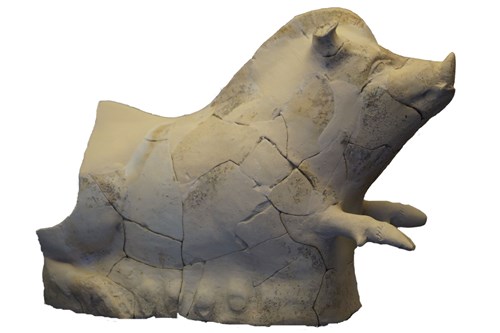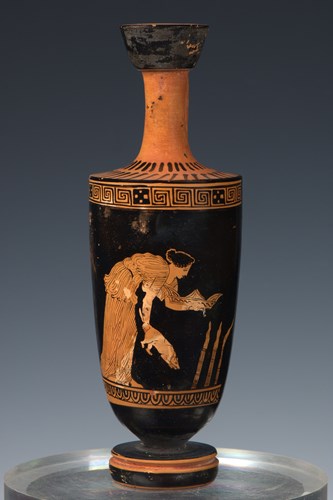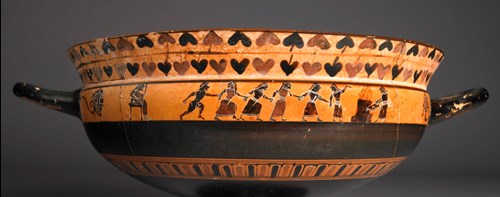The Thesmophoria was among the most popular and widespread ancient Greek festivals in honour of Demeter. The festival is attested in fifty cities throughout Greece, Asia Minor, Sicily, southern Italy, and North Africa. The celebration lasted for three or four days and involved several rituals. The Thesmophoria was exclusively a women’s festival and promoted human and agricultural fertility. The festival’s most notable aspect was the retrieval of the rotten remains of pigs from snake-infested pits known as “megara”. The putrid meat was mixed with seeds and placed on the altar before its distribution to the members of the community. There was a widespread belief that whoever mixed these remains with his sowing would have a great harvest.

Ceramic figurine of a sow, Inv. no. Π 12395A. Discovered during the excavation of the Sanctuary of Demeter Chamyne, near the Archaeological Site of Olympia, 4th century BCE, sculpture, Αρχαιολογικό Μουσείο Πύργου © Αρχαιολογικό Μουσείο Πύργου
However, there is some ambiguity concerning the timeline because we do not know when the pigs were thrown into the megara. It would take some time for the carcass to rot, so it is possible that this part of the celebration occurred many months before the festival. In Eleusis, the throwing of the pigs may have happened in the early fall in connection with the celebration of the Greater Mysteries. The ritual may indicate a strong Orphic influence. According to the Orphic version of the Eleusinian story, the pigs of Eubouleus fell into the chasm that opened when Hades snatched Persephone. Three pits in front of the Telesterion in Eleusis have been identified as the megara of Demeter.

Red-figure lecythus showing a young woman about to throw a piglet into the megaron, 5th century, vessel, National Archaeological Museum © Hellenic Ministry of Culture and Sports/ Hellenic Organization of Cultural Resources Development
In Athens, the celebration lasted for three days on 11-13 Pyanepsion (October-November), before ploughing and sowing, since the festival’s purpose was to ensure the germination of the seed. The Thesmophoria was limited to the wives of Athenian citizens. Men were forbidden to intrude on the sacred rites. The first day was called anodos. The women of Athens formed a procession and visited the Thesmophorion, the temenos of Demeter, where they erected temporary huts for the duration of the festival, offered sacrifices, and danced on various occasions. The second day was dedicated to fasting (nesteia). No solid food was permitted. Instead, the women sat on the ground in memory of Demeter’s selection of a plain stool (rather than a fancy couch) in the palace of Celeus in Eleusis. The third day was called Kalligeneia and included a great feast in honour of “the goddess of beautiful offspring”. According to Athenian law, a husband with a fortune of three talents had to provide dinner for his wife at Thesmophoria.

Black-figured kylix possibly showing a scene from the Attic Thesmophoria (a), The Painter of the Burgon Sianas, 560-550 BCE, vessel, The British Museum © The Trustees of the British Museum
It was during this day that certain women called bailers (antletriai) descended into the sacred underground chasms and retrieved the holy compost and various sacred objects (apart from pigs) prepared from dough that imitated snakes and other phallic and sexual symbols, as well as pine shoots thrown into the megara by the women to ensure the promotion of the fertility. The festival was a time of great licence for the female participants, who used foul language as part of the fertility rituals. The Greek astronomer Cleomedes compared the women’s language (aischrologia) during the Thesmophoria to the vocabulary often used by prostitutes.







